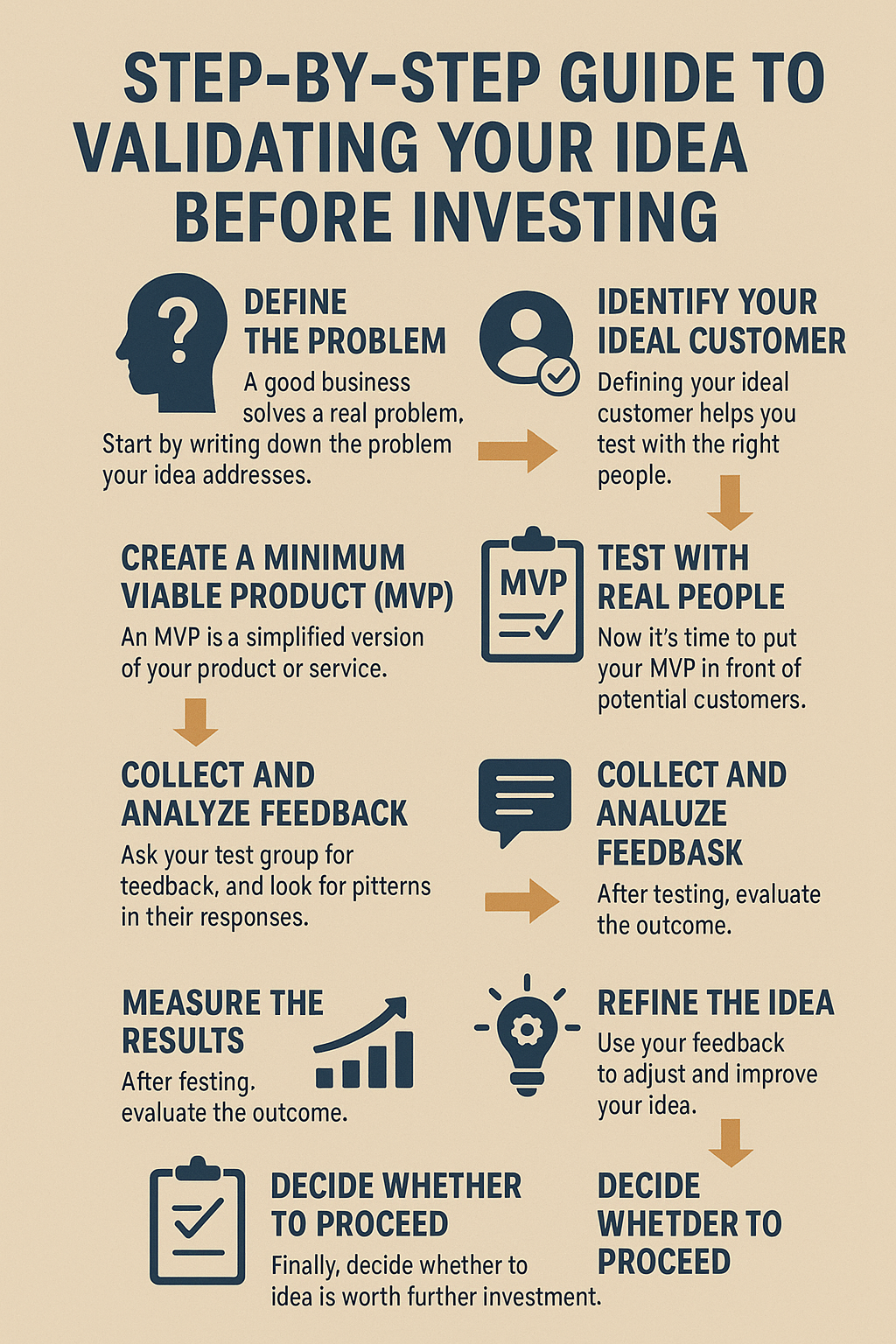Many entrepreneurs rush into launching their businesses without testing their ideas first. This often leads to wasted time, money, and frustration. The truth is, not every idea is worth pursuing—and that’s okay. The goal of validation is to confirm whether your idea solves a real problem for real people who are willing to pay for it.
In this article, we’ll break down a practical step-by-step guide to validating your idea before making a big investment.
Why Validation Matters
Validation reduces risk. Instead of guessing, you gather real evidence that your business concept has potential. By validating, you:
- Avoid building something nobody wants.
- Identify your target audience early.
- Save money by avoiding unnecessary expenses.
- Gain confidence in your decision-making.
Think of validation as the foundation of your business. Without it, everything else becomes shaky.
Step 1: Define the Problem Clearly
A good business solves a real problem. Start by writing down the problem your idea addresses.
Ask yourself:
- What pain points do people have?
- How does my idea solve them?
- Is this a big enough problem that people will pay to fix it?
Example: If your idea is a meal prep service, the problem might be: “Busy professionals don’t have time to cook healthy meals during the week.”
Step 2: Identify Your Ideal Customer
Not everyone will buy your product. Defining your ideal customer helps you test with the right people.
Consider:
- Age, gender, income level.
- Lifestyle habits.
- Where they spend time (online and offline).
- What motivates them to buy.
The clearer your customer profile, the easier validation becomes.
Step 3: Research the Market
Research helps you confirm whether your idea has potential demand. Look for:
- Competitors: Who else is offering something similar?
- Market size: Is there enough demand for you to survive?
- Trends: Is the problem growing or shrinking?
Tools to use:
- Google Trends for keyword popularity.
- Social media groups and forums to see what people are discussing.
- Reviews of competitors to spot unmet needs.
Step 4: Create a Minimum Viable Product (MVP)
An MVP is a simplified version of your product or service. It doesn’t need to be perfect—it just needs to deliver the core value.
Examples:
- A landing page with product details and a sign-up button.
- A sample batch of your product sold to a small group.
- A basic version of your app with limited features.
The goal is to test with minimal effort before investing heavily.
Step 5: Test With Real People
Now it’s time to put your MVP in front of potential customers.
Ways to test:
- Share your landing page and see how many sign-ups you get.
- Offer your product at a discount to friends or local groups.
- Run a small ad campaign to measure interest.
- Collect pre-orders if possible.
The key is getting real feedback from real people—not just friends or family who may be biased.
Step 6: Collect and Analyze Feedback
Ask your test group questions such as:
- What did you like about the product/service?
- What needs improvement?
- Would you pay for this? How much?
- Would you recommend this to a friend?
Look for patterns in their responses. If most people highlight the same issue, it’s worth fixing.
Step 7: Measure the Results
After testing, evaluate the outcome:
- Did people show genuine interest?
- How many were willing to pay or commit?
- Did you receive positive or negative feedback?
If your results show strong interest, that’s a good sign. If not, don’t be discouraged—consider adjusting your idea instead of abandoning it entirely.
Step 8: Refine the Idea
Validation is not about proving your idea is perfect from the start. It’s about learning and improving. Use your feedback to:
- Adjust your product features.
- Change your target audience.
- Modify your pricing strategy.
The best businesses often evolve from their original concept.
Step 9: Decide Whether to Proceed
Finally, decide whether your idea is worth further investment. Ask yourself:
- Do I have enough evidence that people want this?
- Am I passionate enough to keep working on it?
- Do the numbers make financial sense?
If the answer is yes, you’re ready to move forward with confidence. If not, you’ve saved yourself from wasting money on something that wouldn’t have worked.
Final Thoughts: Validation is the Smart First Step
Validating your idea may take extra time, but it’s a crucial step for any entrepreneur. Instead of relying on assumptions, you gather proof that your business concept can succeed.
Every successful entrepreneur started with an idea—but only those who tested and refined their concepts built businesses that lasted.
So before investing your savings or quitting your job, validate. It could be the difference between a costly mistake and a thriving business.
